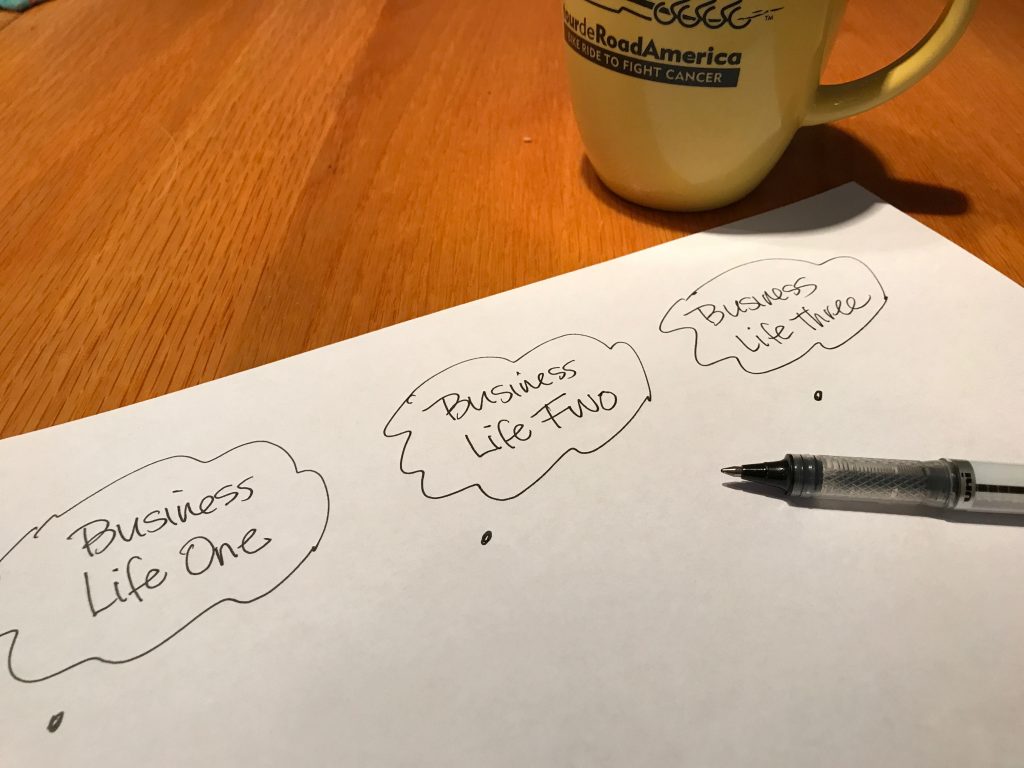Designing Your Life (Bill Burnett and Dave Evans) is focused on applying design thinking to build a well-lived, joyful life. Since so much of our work life is a part of our whole life, it makes sense to apply this to our entrepreneurial pursuits as well.

What is design thinking? Design thinking encompasses four basic tenets:
- Curiosity
- Bias to action
- Reframing
- Radical collaboration
Let’s explore how you can apply design thinking to your small business (and in turn, your life.) First, the theory of design thinking is that you start where you are. Not where you’d like to be with your business, but where you are. And you look at three basic factors in coherency in your life:
- Who you are
- What you believe
- What you are doing
These three factors constitute a well-lived life – and I propose – a well-lived business life. For all of us in small business, our companies are inextricably linked to our personal lives. For most of us, linking our personal beliefs and who we are comes naturally to our businesses. When we think of the clients we are lucky to work with (you, yes, you!) we note that 100% of them are passionate about their businesses in a way that transcends mere financial acquisition. Growth is measured in the impact that your businesses have on your clients (and in turn, our growth is measured by the impact that we have on your business.) You started your company because you wanted to change the world (or at least your own corner of it.)
According to Burnett and Evans, what makes work fun is when you are leaning in to your strengths, and are deeply engaged and energized by what you are doing. It’s not vacations, salary, or office parties. It’s purpose.
Design thinking, though, isn’t just finding that one great idea that works for your businesss, it’s about finding many ideas so that you can explore the possibilities of your future. It’s about changing your business. In our company (the first iteration of which I founded in 1989), I always tell our new incoming class of interns that I started in the marketing business before the internet existed. And I share that the first iteration of my business was crafting advertising for other small businesses. Words, messages, images – the business of strategy and story – has not changed. We began developing web sites in 1995 and built a business on that through the mid-to-late 2000s. We’ve now transcended that because we’re now entering an age of tool empowerment. Clients need us to craft and execute strategy, while developing and communicating their stories. What will change in the next 10 years? It doesn’t really matter, because there are so many great ideas and possibilities to help small business. It’s that kind of thinking that can help transform your company. Design thinking helps make this all happen.
There are a certain class of things – the authors term these anchor problems – are ones that won’t go away. They’re the big things that we think are our problems, but when reframed are not our problems at all. It might be that we think the way to grow is to get an office or hire a lot of staff, when utilizing a network of contractors and remote employees may help us achieve what we want without having to confront the burden of extra expenses. It might be an anchor problem of buying equipment, when we could use community or collaborative facilities (think development kitchens or maker studios with CNC machines) instead.
Getting beyond the anchor problem (the gravity problem – you can’t change the fact that we live on Earth and it has gravity), requires prototypes. These are ways of working that you try on and see if they work. Every setback becomes a learning point for tweaking your prototype. And the more prototypes you try, the more likely you’ll find the one that will be successful. If you don’t try it, though, you can’t know if the prototype will work.
The book explores how you can develop life scenarios. Some years back, I began a series in my (personal) blog entitled What Would Your Life Look Like If… WWYLLI. In this series, I crafted a blog post around every possible scenario I thought I could have in my life – going back to school and becoming a college design/art professor, changing the kind of company I ran (more product, less service), becoming a medical professional, staying home with my kids – the field was wide open. What I discovered in these posts is that freedom was the common denominator of all of these. This exercise (as outlined by the authors) goes like this:
- Life one: (business life one) What you do right now
- Life two: what you’d do if the Thing One were suddenly gone
- Life three: The thing you’d do if money or image were no object
Applying this to business is easy. And, for many of us, it’s a path (from life one to life three). The book calls these Odyssey Plans, and the approach taken is to develop three alternative five-year plans.
- Give each plan a six-word title.
- Write out three questions out of each version
- Rank each alterative based on resources, likability, confidence and coherence (how well it satisfies the coherence test above)
- Present the plan to another person – a business mentor, your spouse, a life coach
- And note how each alternative energizes you
There are additional steps to design thinking (including prototyping) that you can take to test out these Odyssey Plans before you decide to change or implement one. I highly recommend the book and the tasks within it. It is designed for your life. I’ll argue that for the clients reading this article, your business IS your life – maybe not all of it, but a big, emotional part of it. But you’ll gain valuable insight from it. I checked it out from my public library, thus saving myself from adding another book in my (extensive and almost overwhelming) business book home library.
Applying design thinking to your small business will help transform your business. You might discover a side area of your business (training, for instance, or a new product line) may be the winner of the Odyssey Plan and you might turn your company in that direction to purse that prototype. You might discover that prototype isn’t sustainable, and you might go back to your original business path – but in all of these cases, short, relatively risk-free prototyping can give you insight into where you might take the rest of your (business) life. Go for it!
If you want help crafting strategy from these three Odyssey Plans for your business, it’s a good idea to sit down and plan for it. A marketing assessment can help you prototype a small, relatively risk-free step for your business (developing and launching a new product or service, for instance.) Let’s talk!






